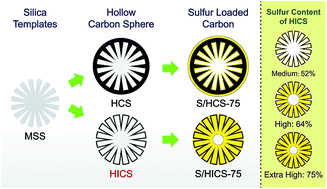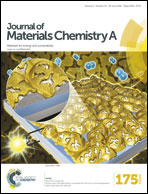Trapping sulfur in hierarchically porous, hollow indented carbon spheres: a high-performance cathode for lithium–sulfur batteries†
Abstract
Hierarchically porous hollow carbon spheres with an indented void structure have been designed as hosts for high-performance cathode materials for lithium–sulfur batteries. With a diameter of approximately 100 nm and a pore volume of 3.72 cm3 g−1, the hosts can retain sulfur within the porous structures, including the external cone-like cavities, the porous carbon shells, and the inner linings. The exquisite indented structure provides excellent electron and Li-ion pathways while the symmetrically indented voids evenly alleviate the stress induced by the volume change during cycling. The oxygen functional groups further relieve the shuttle effect of polysulfide. A composite electrode with 52% sulfur loading demonstrates a remarkable initial discharge capacity of 1478 mA h g−1 at 1/10C (1C = 1675 mA g−1), corresponding to 88% sulfur utilization. Even when the sulfur/carbon (S/C) ratio of the composite is increased threefold from 1 : 1 to 3 : 1 (75% sulfur loading), a very high capacity retention is still maintained, achieving an ultraslow rate of capacity fading, ∼0.047% per cycle over 1200 cycles at 1/2C.



 Please wait while we load your content...
Please wait while we load your content...